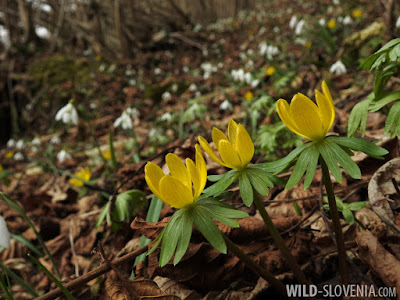Yesterday we ventured into eastern Slovenia, to visit a place we've never been before - the Kozjansko Regional Park. This protected area comprises vast beech forests, open meadows, old orchards, small villages and river valleys. It is a rather overlooked part of Slovenia, although the wildlife there is really amazing. You can read plenty of facts about the wildlife diversity and local specialities on the
park's website.
At this time of year, certainly the biggest attraction for nature enthusiasts (including ourselves) is a small, but very interesting plant - the Winter Aconite Eranthis hyemalis. It is a species native to
south-eastern Europe and is quite rare in Slovenia, with just a couple
of localities, virtually all encompassed in the Kozjansko Regional Park.
In the park however, it can be really numerous and can form nice stands
in early spring. It is usually one of the first flowers to emerge, just
after the snow has melted, along with the far-commoner and widespread
Snowdrop Galanthus nivalis.
 |
| Winter Aconite Eranthis hyemalis |
The Kozjansko area is also rich with other interesting flora we are not used to see in other parts of Slovenia. During our walk in the beech forests near Podsreda we also enjoyed the beautiful "Dark Purple Hellebore" Helleborus atrorubens, another speciality of this area, which can be frequently found in the company of the commoner Fragrant Hellebore Helleborus odorus and with which it also hybridizes. Other early spring plants were also in beautiful show, including commoner and widespread species. We also found several fungi, among which the most interesting were up to 6 different Elf Cups Sarcoscypha austriaca growing on the forest path.
 |
| "Dark Purple Hellebore" Helleborus atrorubens |
 |
| Fragrant Hellebore Helleborus odorus |
 |
| Christmas Rose Helleborus niger |
 |
| Alpine Squill Scilla bifolia |
 |
| Snowdrop Galanthus nivalis |
 |
| Spring Snowflake Leucojum vernum |
 |
| Spineless Butcher's-broom Ruscus hypoglossum |
 |
| Alternate-leaved Golden Saxifrage Chrysosplenium alternifolium |
 |
| White Butterbur Petasites albus |
 |
| Yew Taxus baccata |
 |
| Elf Cup Sarcoscypha austriaca |
In the beech forests, among birds, the most interesting (and most prominent) were woodpeckers. We heard 2 Middle Spotted Woodpeckers Dendrocopos medius, 1 Grey-headed Picus canus, 2 Black Dryocopus martius and several Great Spotted Woodpeckers Dendrocopos major. The forests of the Kozjansko Regional Park are also home to some pairs of Ural Owl Strix uralensis, Collared Flycatcher Ficedula albicollis as well as Black Stork Ciconia nigra.
 |
| Black Woodpecker Dryocopus martius (male). |
 |
| Beech Fagus sylvatica forest. |
The Kozjansko Regional Park has many slow-flowing rivers and streams that have become the new home of a recent, but very welcome colonizator, the Beaver Castor fiber. These animals have re-colonised Slovenia after years of absence. They arrived from nearby Croatia, where the species was re-introduced in the past decades. Nowadays Beavers can be found in several rivers in eastern and southeastern Slovenia, although they are very difficult to observe by day. Being mainly nocturnal they are active at night and quite a good measure of luck is needed to spot one. Nevertheless, the signs of their activity are visible along the rivers. We found several freshly-eaten trees and branches along a local stream, as well as "paths" leading from the water and a possible den. Otters Lutra lutra are also said to inhabit the park, but they can be even more difficult to spot!
 |
| Signs of Beaver Castor fiber activity. |
 |
| Stone Loach Barbatula barbatula in a stream. |
On our way to and from Kozjansko we passed the town of Krško, in the Sava river basin. Here we stopped along a main road to admire one of the very few breeding colonies of Rook Corvus frugilegus in Slovenia. The wider area of the river's Sava and Krka confluence has been the historic stronghold of this species in the country. Today Rook has colonised also a few other sites in central and northeastern Slovenia, but it remains a rare breeder. In winter the population is enlarged by overwintering birds from northern and eastern Europe.
 |
| Rooks Corvus frugilegus at the colony. |

























